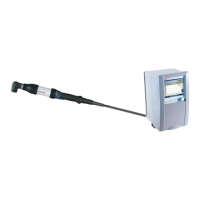3 608 878 300 Tightening Technology | Bosch Rexroth AG 503/641
System 350 | 3 608 878 300/2019-03
These characteristics are generated per activated docu buffer (if monitoring functions are available), see
Tightening results from several steps of a tightening process on page 209. The torque threshold actual
value is not represented by a characteristic - however, it is included in the graph data.
Graphs
Currently, only angle/torque graphs are transmitted (the QDA protocol does not support other graph
types or more than one Y axis).
The transmission of the graphs can be configured for each tightening position. Via the parameter graph
filter , the following options can be selected:
• No graph transmission for the tightening position (no graph)
• Graph transmission only for OK or only for NOK tightening processes (only OK graph or only NOK
graph)
• Always graph transmission (OK and NOK graph)
In the tightening program itself (in the start step), the desired graph length (in points) can be defined. A
maximum of 2000 graph points can be set. If the tightening process generates more graph points, the
oldest may be removed.
K fields
6.13.2 Settings in the BS350 operating system
QDA protocol is configured via the BS350 operating system.
The configuration window can be opened in two different ways. This depends on the question whether
the BS350 is connected to a tightening system ("online") or not ("offline"):
• Online: System QDA configuration
If no configuration file is stored on the tightening controller, a message is output and the configuration
window is not opened:
• Offline: File New QDA configuration
The configuration window is divided as follows:
• Configuration of the target server, see (page 507)
• Definition of path information and ID codes, see (page 505)
• Configuration of the tightening position definition, see (page 506)
Table 6–182: K fields
K field Description
K0001 Measurement
K0002 Status (0 = available, 255, empty)
K0004 Date/time
K0100 Selection of the transmission type:
K0014 ID code
K0055 Number of repeated attempts
K0056 Results status: OK/NOK
K0057 Quality code text
K1001 Part number (ID/config)
K1002 Test plan (config)
K1086 OP/AVO (config)
K1201 Location name (with "-", max. 40 characters)
K1202 Hardware identifier (serno/spindle ID)
K2001 Characteristic number (serial no.)
K2002 Characteristic name (tightening position name + characteristic identification)
K2003 Characteristic identifier (channel/prg/step...)
K2009/K2022 Units/decimal places
K2101-K2121 Limits, values & type
K2142 Characteristic type

